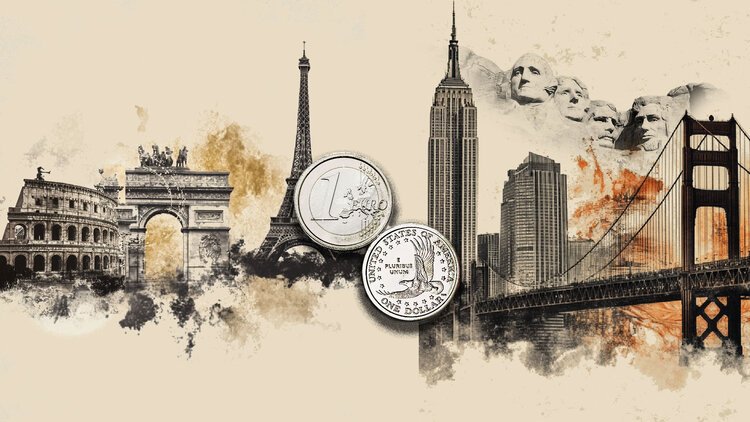- EUR/USD edges lower as traders await clues of when the Fed may cut rates.
- Minutes from the June FOMC and changes in rate expectations could serve as an additional catalyst for EUR/USD.
- Euro strength wanes as bullish momentum of the EUR/USD uptrend fades.
The Euro (EUR) is trading flat against the US Dollar (USD) on Wednesday as investors turn cautious ahead of key US economic events.
As markets continue to search for clues about when the Federal Reserve (Fed) may begin cutting rates, the Minutes from the June Meeting and a US Treasury bond auction are in focus.
Ahead of these events, EUR/USD remains in a narrow range with prices hovering above 1.1700 at the time of writing.
US 10-year bond auction and FOMC Meeting Minutes set tone for EUR/USD
The Federal Open Market Committee (FOMC) Meeting Minutes provide details about how Fed Board Members perceive the current economic conditions. It also provides insight into inflation and employment trends, which directly influence expectations for interest rates. As US President Donald Trump continues to call for the “immediate resignation” of Fed Chair Jerome Powell, markets are pricing in a rate cut for September. This has provided some support for US Treasury yields and the Greenback on Wednesday.
Additionally, the US Treasury’s 10-year bond auction, scheduled for 17:00 GMT, is drawing considerable market interest.
A bond auction is a process where the US government issues new debt by selling bonds to investors, and its outcome can significantly influence bond yields.
Rising yields typically strengthen the US Dollar by making it more attractive to investors seeking higher returns, which can potentially impact currency pairs such as EUR/USD.
EUR/USD nears 1.1700 as bullish momentum fades
EUR/USD is currently trading above the 1.1700 psychological level after testing a new YTD high of 1.1803 last week. The 20-day Simple Moving Average (SMA) is providing support at 1.1651, just above the 23.6% Fibonacci retracement level of the May-July uptrend near 1.1650.

The Relative Strength Index (RSI) is hovering around 60, indicating that bullish momentum has waned, although the broader tone remains neutral to positive. Immediate resistance lies at the 10-day SMA of 1.1749, which could open the door for the 1.1800 psychological level and the recent swing high of 1.1830.
With support clustered around the 23.6% Fibo retracement and the 20-day SMA, a decisive break below this confluence could expose the pair to further downside toward the 38.2% Fib level at 1.1538.
On the flip side, a move back above 1.1749 would revive bullish momentum and open the door for a retest of the recent peak. Traders are likely to focus on the 1.1650 area for near-term directional cues.
US Dollar FAQs
The US Dollar (USD) is the official currency of the United States of America, and the ‘de facto’ currency of a significant number of other countries where it is found in circulation alongside local notes. It is the most heavily traded currency in the world, accounting for over 88% of all global foreign exchange turnover, or an average of $6.6 trillion in transactions per day, according to data from 2022.
Following the second world war, the USD took over from the British Pound as the world’s reserve currency. For most of its history, the US Dollar was backed by Gold, until the Bretton Woods Agreement in 1971 when the Gold Standard went away.
The most important single factor impacting on the value of the US Dollar is monetary policy, which is shaped by the Federal Reserve (Fed). The Fed has two mandates: to achieve price stability (control inflation) and foster full employment. Its primary tool to achieve these two goals is by adjusting interest rates.
When prices are rising too quickly and inflation is above the Fed’s 2% target, the Fed will raise rates, which helps the USD value. When inflation falls below 2% or the Unemployment Rate is too high, the Fed may lower interest rates, which weighs on the Greenback.
In extreme situations, the Federal Reserve can also print more Dollars and enact quantitative easing (QE). QE is the process by which the Fed substantially increases the flow of credit in a stuck financial system.
It is a non-standard policy measure used when credit has dried up because banks will not lend to each other (out of the fear of counterparty default). It is a last resort when simply lowering interest rates is unlikely to achieve the necessary result. It was the Fed’s weapon of choice to combat the credit crunch that occurred during the Great Financial Crisis in 2008. It involves the Fed printing more Dollars and using them to buy US government bonds predominantly from financial institutions. QE usually leads to a weaker US Dollar.
Quantitative tightening (QT) is the reverse process whereby the Federal Reserve stops buying bonds from financial institutions and does not reinvest the principal from the bonds it holds maturing in new purchases. It is usually positive for the US Dollar.

